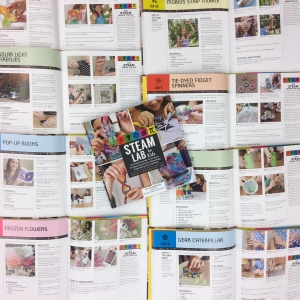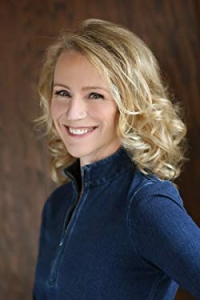 Connecting the Dots of Science and Art
Connecting the Dots of Science and Art
Growing up Liz Heinecke was surrounded by science, nature, art, and the love of family. You can see all of these things in her work now as an accomplished science communicator and educator. As an undergraduate at Luther College she studied music and biology and then worked in research labs in Madison, Wisconsin. She received a Master’s degree in bacteriology while working in Jon Woods’ lab at UW-Madison. Note: Dr. Woods received a New Investigator Award in Molecular Pathogenic Mycology from the Burroughs Wellcome Fund, which founded the SMT Center.
In the early 2000s she found herself in front of a rapt audience of three young children. She was intent on teaching them about science using items that were readily available in her kitchen and blogged about the experience in Kitchen Pantry Scientist. This led to a connection to a morning news show in the Twin Cities where she talked about experiments parents can do with their children in their home. This led to a NASA Tweetup at Kennedy Space Center for a space shuttle launch.
“My career has evolved from liking science as a kid to teaching science as an adult and embracing opportunities along the way,” Heinecke said.
Her first book, Kitchen Science Labs for Kids, came out in 2014 along with a smartphone app. In 2016, she published the Outdoor Science Lab for Kids. In May 2018, the SMT Center had a chance to chat with Ms. Heinecke to discuss her recent book, STEAM Lab for Kids.
 Your books have a very cookbook style feel to them – what led you to that format?
Your books have a very cookbook style feel to them – what led you to that format?
It has always been important to me to make science accessible to everyone. My mom had a cooking school at one point and most people are not afraid of tackling a recipe on a bag of chocolate chips and make cookies. I thought that if I made my science books like cookbooks people would not be afraid to try the experiments in them. I explain in my books that scientific protocols are just recipes for doing science. All of my science books are like cookbooks. I have step-by-step pictures of the experiments because I find that it’s encouraging to see what you’re doing. It also provides the opportunity to use nice photography instead of black and white drawings. I guess I take the Martha Stewart approach and try to make science look pretty.
I want parents to be able to go into their kitchen junk drawer or into their pantry and be able to pull things out for their kids to enjoy. Science should never be too expensive or so hard that you’re not able to go to your cupboard and pull out some corn starch, baking soda, and vinegar so kids can experiment in the sink, driveway, or kitchen table. It gives kids a chance to really delve deeper into what they are exploring. Our schools do a great job but there are limited time and resources. Time is a very important aspect of scientific exploration. I love the idea of families doing science at home where there are no time limits, no judgment, no grades. Just an opportunity to experiment.
They are very beautiful books.
I work with a great photographer named Amber Procaccini, who captures the beauty of the experiments and the excited faces of the kids doing them. The art department at Quarry Books does a beautiful job with layout.
I do this to encourage kids and parents to do science at home. What’s been so cool about this whole experience is that kids will look at something and try it. Kids can flip through these books and try something.
What was the inspiration behind the STEAM book and how it differs from your others?
It differs quite a lot. My other two books are definitely science books and there’s some math and engineering involved. With this book I was very interested in making the projects art focused. I tried to show kids that design is important and in anything you can do you can bring an artist’s eye to it. There’s also some art history in the book. I think kids want to find out more about certain artists or certain kinds of art or even mathematicians. There’s so much art tangled in science and mathematics. One thing I love about this new book is that I was able to incorporate quotes from really interesting people who use both STEM and art in their everyday jobs or their passions. Besides the experiments, I’m hoping that kids read the text and become inspired by some of these STEAM role models.
How do you see Arts fitting into the disciplines of science, technology, engineering, and mathematics?
Anyone who is passionate about STEM, whether they know it or not, is probably incorporating things they learned about other disciplines. I think interdisciplinary learning creates extraordinary people in all fields. A great engineer may have in the back of her mind images of the bridges she studied in art class. Everything is inspired by the things in our past, which mold and shape the way we think and create. I think that the more art a student is exposed to, the more she will be creative in the STEM fields. One reason I love incorporating art and STEM is that you can get kids who are not naturally drawn to STEM interested in the fields by providing an approach through art. I think interdisciplinary learning is so important – the stories we hear, the movies we see, the music we listen to all influence the way we create things in the future.
###
Follow Liz on Twitter.
Try “Crystal Creatures” from STEAM Lab for Kids: PDF
For information on STEM projects in North Carolina, visit ncstemcenter.org.
Interview conducted and edited by Russ Campbell